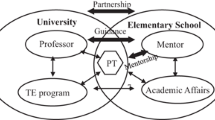Abstract
This study examined the use of science professors acting as mentors to enhance the science competency of early childhood educators. Findings indicate that mentor-mentee dyad interactions varied; however, mentors were able to assist with curriculum, science content, and resources. Although standards-based units were developed, there was little “real” science inquiry present. Findings did not support a higher-quality product that involved a mentoring relationship versus a nonmentoring relationship. The mentors’ lack of impact may have resulted from how the teacher candidate/science professor dyads “positioned” themselves relative to the others in developing a standards-based science unit.
Similar content being viewed by others
References
Bransford, J., Brown, A., & Cocking, R. (Eds.). (1999).How people learn: Brain, mind, experience and school. Washington, DC: National Academy Press.
Bredekamp, S., & Copple, C. (Eds.). (1997).Developmentally appropriate practice in early childhood programs. Washington, DC: National Association for the Education of Young Children.
Bybee, R. (2002). Scientific inquiry, student learning, and the science curriculum. In R. Bybee (Ed.),Learning science and the science of learning (pp. 25–35). Arlington, VA: NSTA Press.
Davies, B., & Harre, R. (2000). Positioning: The discursive production of selves. In B. Davies, (Ed.),A body of writing, 1990–1999 (pp. 87–106). Walnut Creek, CA: AltaMira Press.
Debolt, G. P. (Ed.). (1992).Teacher induction and mentoring. Albany: State University of New York Press.
Hedges, K., & Mania-Farnell, B. (2002). Mentoring students in an introductory science course.Journal of College Science Teaching, 32(3), 194–198.
Hudson, P. (2003). Seeing the light: Mentoring and primary science.Investigating: Australian Primary & Junior Science Journal, 20(2), 15–19.
Jonson, K. F. (2002).Being an effective mentor: How to help beginning teachers succeed. Thousand Oaks, CA: Corwin Press.
Koch, J., & Appleton, K. (2003).The effect of a mentoring model for elementary science professional development. Paper presented at the International Association for the Education of Teachers in Science, Nashville, TN.
Kochan, F. K. (2002). Examining the organizational and human dimensions of mentoring: A textual data analysis. In F. K. Kochan (Ed.),The organizational and human dimensions of successful mentoring programs and relationships (pp. 269–286). Greenwich, CT: Information Age Publishing.
Market Research Institute. (2004).The Bayer facts of science education X: Are the nation’s colleges and universities adequately preparing elementary schoolteachers of tomorrow to teach science? Available online: www.bayerus.com/msms/news/facts/ pdf/040511_Exec_Summary.pdf.Retrieved August 31, 2005.
Martin, A. (2002). The DART Mentor Teacher Model. In F. K. Kochan (Ed.),The organizational and human dimensions of successful mentoring programs and relationships (pp. 121–140). Greenwich, CT: Information Age Publishing.
Morgan, D. L. (1998).The focus group handbook. Thousand Oaks, CA: Sage.
National Center for Educational Statistics. (2003).The nation’s report card: Science 2000 major results. Available online: http://nces.ed.gov/nationsreportcard/ science/results?. Retrieved June 15, 2005.
National Council for the Accreditation of Teacher Education (NCATE). (2002).Professional standards for the accreditation of schools, colleges, and departments of education. Available online: www.ncate.org/documents/unit_stnds_2002.pdf. Retrieved June 14, 2005.
National Research Council (NRC). (1996).National Science Education Standards. Washington, DC: National Academy Press.
No Child Left Behind. (2002).Fact sheet. Available online: www.ed.gov/nclb/landing.jhtml?src=pb. Retrieved June 14, 2005.
Odell, S. (2003, August 11).Keynote address. Presented to the Association of Teacher Educators, Santa Fe, New Mexico.
Quinn, F., Muldoon, R., & Hollingworth, A. (2002). Formal academic mentoring: A pilot scheme for first-year science students at a regional university.Mentoring & Tutoring, 10(1), 21–33.
Van Zee, D., Lay, D., & Roberts, D. (2003, July). Fostering collaborative inquiries by prospective and practicing elementary and middle school teachers.Science Teacher Education, 87(4), 588–612.
Author information
Authors and Affiliations
Corresponding author
Rights and permissions
About this article
Cite this article
Katz, L., Sadler, K. & Craig, D.V. Science professors serve as mentors for early childhood preservice teachers in the design and implementation of standards-based science units. J Elem Sci Edu 17, 43–55 (2005). https://doi.org/10.1007/BF03174680
Received:
Issue Date:
DOI: https://doi.org/10.1007/BF03174680




